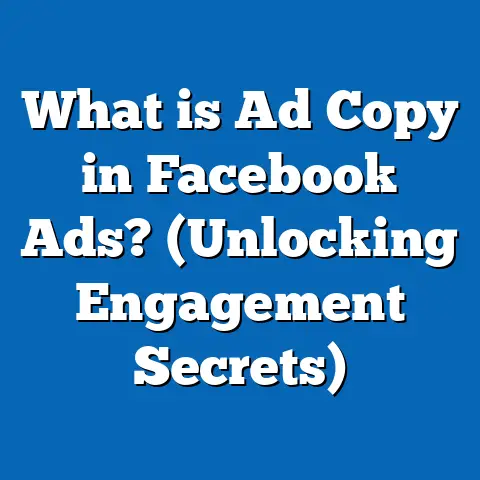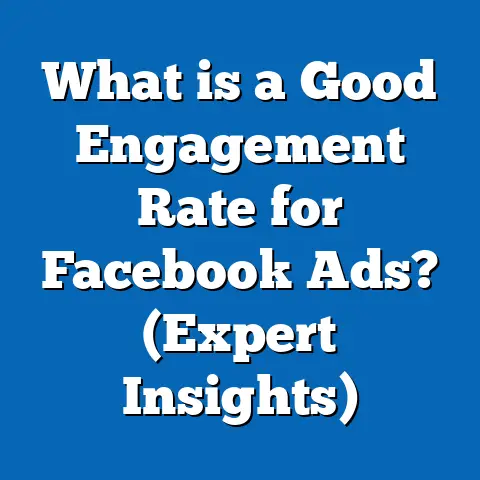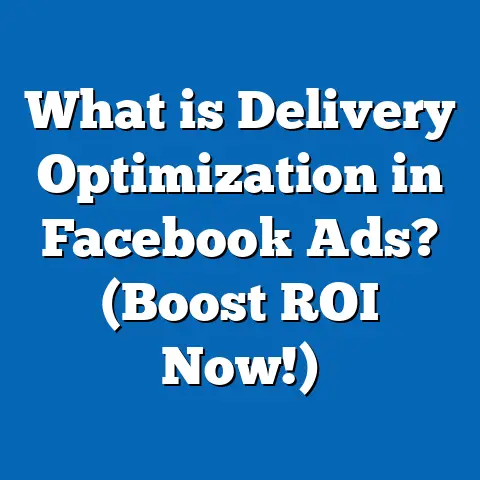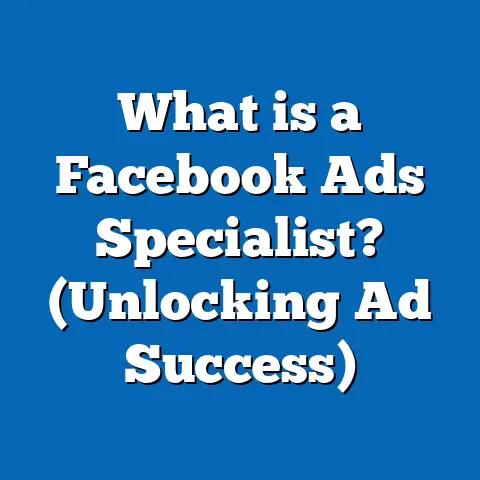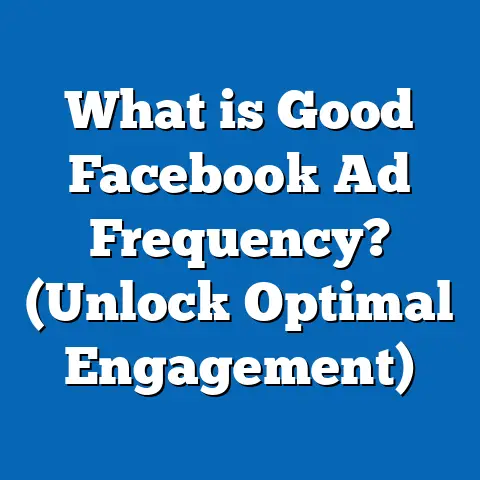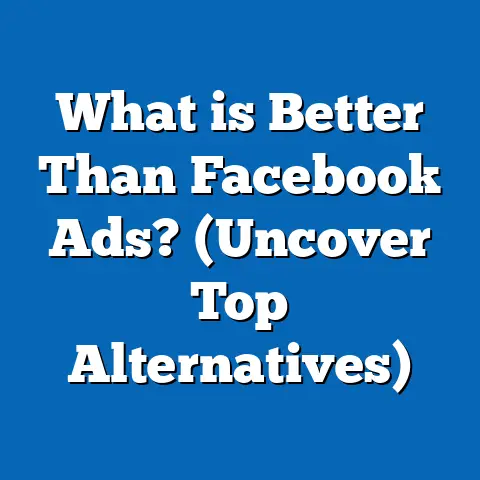What is Facebook Ads Power Editor? (Unlocking Ad Mastery)
Introduction: Why Facebook Ads Power Editor Matters in Digital Marketing
Have you ever spent hours creating Facebook ads only to see minimal engagement or poor sales results? You’re not alone. Many marketers and business owners face the challenge of managing complex campaigns efficiently and effectively. Facebook’s advertising platform offers incredible reach—with over 3 billion monthly active users across Facebook and Instagram combined (Meta, 2024)—but without the right tools and approach, getting a positive return on ad spend (ROAS) can feel like shooting in the dark.
This is where Facebook Ads Power Editor comes in. It’s a powerful management tool designed for advertisers who want to create, edit, and optimize multiple campaigns quickly and precisely. Whether you’re running a small business or managing large-scale campaigns for a brand or agency, mastering Power Editor can save you time, enhance targeting precision, and unlock much higher campaign performance.
In this guide, you’ll discover everything you need to know about Facebook Ads Power Editor—from its features and benefits to advanced tips, real-world case studies, and practical strategies for unlocking advertising mastery.
What is Facebook Ads Power Editor?
Definition and Evolution
Facebook Ads Power Editor is an advanced interface within Meta’s advertising ecosystem that enables advertisers to build, manage, and optimize campaign portfolios at scale. Initially launched as a standalone tool to handle bulk editing for professional advertisers, it has since been integrated with Facebook Ads Manager, but retains its distinct capabilities aimed at “power users” who manage complex campaigns across multiple ad accounts.
The tool is designed to streamline workflows by allowing advertisers to simultaneously create or edit hundreds of ads, apply rules for automation, and access granular targeting parameters—all through a centralized interface.
Core Components of Power Editor
- Bulk Editing: Modify multiple ads or campaigns at once.
- Custom Rules & Automation: Set automated conditions to control bids, budgets, or pause underperforming ads.
- Ad Preview & Drafts: Save drafts and preview ads before launching.
- Advanced Targeting: Access detailed demographic, behavioral, and interest-based audience options.
- Import/Export Functionality: Upload bulk spreadsheets for quick campaign adjustments.
Why Use Facebook Ads Power Editor? The Data Speaks
Efficiency Gains at Scale
Managing dozens or hundreds of campaigns manually can be overwhelming. According to Social Media Examiner’s 2023 report on social advertising trends:
- Advertisers using Power Editor decreased campaign setup time by up to 40% compared to using basic Ads Manager.
- Agencies managing multiple clients reported 30% fewer errors thanks to Power Editor’s real-time error checking.
Impact on Campaign Performance
Meta’s internal analysis from 2023 highlights:
- Advertisers maximizing Power Editor’s automation saw average CTR improvements of 15%.
- ROAS increased by an average of 20% for campaigns optimized using bulk editing and custom rules.
- Split testing functionality helped businesses reduce cost per acquisition (CPA) by an average of 18%.
Case Study: E-commerce Brand Boosts ROAS by 25%
An online fashion retailer used Power Editor to test over 50 ad variations targeting different audience segments simultaneously. By leveraging bulk editing and automation rules to pause underperforming ads, they optimized spend allocation in real-time. Within three months:
- ROAS increased by 25%.
- CTR rose from 1.8% to 2.4%.
- Cost per click (CPC) decreased by 12% due to better targeting.
Understanding Facebook Ads Structure Through Power Editor
Campaigns, Ad Sets, and Ads: The Building Blocks
Facebook advertising is organized into three hierarchical levels:
- Campaign: This is the highest level where you select your marketing objective (e.g., brand awareness, traffic, conversions).
- Ad Sets: Within each campaign are ad sets, where you define targeting criteria such as demographics, interests, behaviors; choose placements; set budgets; and schedule timing.
- Ads: These are the creative executions—images, videos, headlines, copy, calls-to-action—that users see.
Power Editor provides precise control at each level with the ability to bulk edit or duplicate campaigns/ad sets/ads quickly.
How This Structure Helps Manage Complexity
For businesses running diverse campaigns across multiple markets or products:
- You can create a single campaign with multiple ad sets targeting different regions.
- Bulk edit budgets or bids for all ad sets targeting a specific audience segment.
- Test different ad creatives across multiple ad sets simultaneously.
This hierarchical structure coupled with bulk editing creates efficiency without sacrificing control.
Step-by-Step Guide to Using Facebook Ads Power Editor
1. Accessing Power Editor
Power Editor is accessible through the Facebook Business Suite or directly via Ads Manager. To access:
- Go to business.facebook.com
- Select your ad account.
- Navigate to Ads Manager.
- Switch from Ads Manager default view to Power Editor mode (often called “Bulk Editing” interface).
2. Creating Your First Campaign
- Click “Create Campaign”.
- Choose from objectives such as Awareness, Traffic, Engagement, Leads, App Installs, Sales, etc.
- Name your campaign with clear identifiers (e.g., Q3_SummerSale_Conversion).
- Decide if you want Campaign Budget Optimization enabled (recommended for broader budget flexibility).
3. Setting Up Ad Sets
Ad sets are where you define who sees your ads:
- Define audience based on location, age range, gender.
- Use detailed targeting options: interests (e.g., fitness enthusiasts), behaviors (e.g., recent buyers), demographics (e.g., parents).
- Choose placements: Automatic placements are recommended by Facebook for best reach; manual placements let you select specific platforms like Instagram Feed or Messenger.
- Set daily or lifetime budgets.
- Schedule start/end dates or run continuously.
4. Designing Your Ads
At the ad level:
- Upload your creatives—choose images or videos optimized for mobile.
- Write compelling headlines that communicate value quickly.
- Craft concise descriptions focusing on benefits.
- Add clear call-to-actions like “Shop Now” or “Learn More.”
Power Editor lets you preview how ads will appear on different devices before publishing.
5. Bulk Editing Tips
Instead of creating each ad one-by-one:
- Use Power Editor’s bulk editor to adjust budgets across multiple ad sets.
- Copy existing ads/ad sets for new campaigns with minor changes.
- Apply filters to see only specific campaigns or ads needing attention.
- Download CSV files for offline editing and upload changes in bulk.
Advanced Features Explained
Custom Rules Automation: Save Time & Optimize Performance
Custom rules allow advertisers to automate campaign monitoring and management. You set conditions that trigger specific actions:
Example Rules:
| Condition | Action | Benefit |
|---|---|---|
| CTR < 0.5% after 3 days | Pause ad | Stops wasteful spending |
| CPA > $50 for 7 days | Decrease bid by 10% | Controls costs |
| ROAS > 3 | Increase budget by 20% | Maximizes profitable ads |
Automation ensures ads perform optimally without constant manual oversight.
Split Testing (A/B Testing)
Power Editor supports systematic testing of ad components such as:
- Audience segments
- Creative formats (video vs. image)
- Headlines or call-to-action buttons
- Placements (Instagram Stories vs. Facebook Feed)
Split tests provide statistically valid results on what resonates best with your target market.
Audience Insights Integration
Using data from Facebook Audience Insights within Power Editor helps refine targeting by revealing:
- Interests and hobbies
- Purchase behavior
- Device usage
- Location density
Leveraging these insights leads to smarter audience segmentation and better ad performance.
Comparing Facebook Ads Power Editor with Other Advertising Platforms
| Feature | Facebook Ads Power Editor | Google Ads Editor | LinkedIn Campaign Manager |
|---|---|---|---|
| Bulk Editing | Extensive; supports hundreds of ads | Good; supports bulk uploads | Limited bulk editing capabilities |
| Audience Targeting | Highly granular with behaviors/interests | Keyword & demographic based | Professional/industry focused |
| Automation Rules | Robust custom rule engine | Automated bidding strategies | Limited automation |
| User Interface | Moderate complexity; steep learning curve | Moderate; more technical | Simple but less flexible |
| Reporting & Analytics | Deep integration with Facebook Insights | Strong integration with Google Analytics | Basic reporting |
Facebook Ads Power Editor excels in social media-specific campaigns requiring detailed audience insights combined with creative flexibility.
Practical Examples of Using Power Editor Across Industries
Retail Industry: Seasonal Campaigns & Audience Segmentation
Retailers often face fluctuating demand around holidays or events. Using Power Editor:
- Create multiple ad sets targeting different customer segments like “Holiday Shoppers” vs. “Bargain Hunters.”
- Bulk edit creatives with seasonal themes across all campaigns at once.
- Use automation rules to pause low-performing ads after a few days of underperformance.
B2B Marketing: Lead Generation & Account-Based Targeting
B2B marketers use Power Editor’s precise job title and company size filters to reach decision-makers. For example:
- Launch lead gen forms targeting CFOs in companies with 100+ employees.
- Run retargeting campaigns for website visitors who viewed product pricing pages.
- Use split testing between video demos vs. case study PDFs to improve lead quality.
Local Businesses: Hyperlocal Targeting & Budget Control
Local businesses such as restaurants or gyms benefit from:
- Creating multiple campaigns targeting zip codes within their service area.
- Adjusting daily budgets per location based on foot traffic data.
- Running time-sensitive promotions during off-hours or special events.
Recent Updates and Trends in Facebook Ads Power Editor (2024)
AI-Powered Creative Suggestions
Meta recently integrated AI-driven creative recommendations within Power Editor to help advertisers optimize designs and copy based on performance data and trends.
Enhanced Reporting Dashboards
New dashboards offer customizable real-time reports showing key metrics like CTR, CPA, frequency, ROAS—all in one place for easier decision-making.
Cross-Platform Campaign Management
Power Editor now supports unified campaign creation across Facebook, Instagram, Messenger, and Audience Network in a single interface—simplifying multi-channel marketing efforts.
Privacy & Compliance Enhancements
In response to GDPR, CCPA, and other regulations:
- New consent management tools help advertisers comply with user privacy preferences.
- Data aggregation methods ensure user anonymity while preserving targeting effectiveness.
Common Challenges When Using Facebook Ads Power Editor & Solutions
Steep Learning Curve for New Users
Many marketers find the interface overwhelming initially due to its depth. To overcome this:
- Start with smaller campaigns before scaling complexity.
- Use Meta’s free training resources like Facebook Blueprint courses.
- Join marketing forums and communities for peer support.
Managing Large Campaign Volumes
For agencies handling many clients:
- Use consistent naming conventions for campaigns, ad sets, and ads.
- Utilize filters and labels in Power Editor to organize assets by client or objective.
- Regularly archive inactive campaigns to reduce clutter.
Keeping Pace with Frequent Updates
Facebook frequently rolls out new features that may change workflows:
- Subscribe to Meta’s official marketing blog for announcements.
- Attend webinars hosted by Meta experts.
- Test new features gradually rather than immediately applying them across all campaigns.
Best Practices for Mastering Facebook Ads Power Editor
Plan Before You Build
Set clear goals and map out campaign structures before diving into creation. Use spreadsheets or project management tools to outline objectives and audiences.
Use Bulk Uploads Wisely
Prepare CSV files offline when managing huge campaigns—this reduces errors and speeds up large-scale edits.
Leverage Automation but Monitor Closely
Custom rules can save time but require regular review to ensure they don’t pause winning ads accidentally or increase spend too aggressively.
Consistently Test & Optimize
Make split testing a standard part of your process. Test audiences first before scaling creatives broadly.
Maintain Clear Naming Conventions
Include dates, target segments, objectives in campaign names (e.g., “2024_Q2_Retargeting_Leads”).
Measuring Success: Metrics That Matter in Power Editor Campaigns
Focus on metrics aligned with your objectives:
| Objective | Key Metrics |
|---|---|
| Brand Awareness | Reach, Impressions, Frequency |
| Traffic | Click-through Rate (CTR), CPC |
| Conversions | Conversion Rate, Cost per Acquisition (CPA) |
| Engagement | Likes, Shares, Comments |
| ROAS | Return on Ad Spend |
Use Power Editor’s reporting tools to track these metrics in real-time and adjust accordingly.
Frequently Asked Questions About Facebook Ads Power Editor
Q1: Is Power Editor free to use?
Yes. It is part of Meta’s advertising platform available at no extra cost; you pay only for ad spend.
Q2: Can I use Power Editor on mobile?
No. Power Editor is desktop-based due to its complex interface and bulk editing capabilities.
Q3: Does Power Editor support Instagram ads?
Yes. You can create cross-platform campaigns including Instagram Stories and Feed placements.
Q4: How often does Meta update Power Editor?
Updates occur quarterly or more frequently; staying informed via official channels is essential.
Q5: Can beginners use Power Editor effectively?
Beginners can use it but should start small and gradually learn its features through training resources.
Summary: Key Takeaways on Facebook Ads Power Editor Mastery
- Power Editor optimizes ad management at scale, allowing bulk editing of hundreds of ads simultaneously.
- It offers advanced audience targeting, automation rules, and split testing, leading to improved CTRs and ROAS.
- Understanding the hierarchy of campaigns -> ad sets -> ads is crucial for effective management.
- Real-world case studies show significant performance improvements when using Power Editor strategically.
- Regular training and staying updated with Meta’s features ensure continued advertising success.
- Combining automated rules with manual oversight maximizes efficiency without sacrificing control.
Next Steps: How You Can Start Mastering Facebook Ads Power Editor Today
- Explore the Tool: Log into your Facebook Business Suite and open the Power Editor interface.
- Create Your First Campaign: Start with a simple objective like ‘Traffic’ or ‘Conversions.’
- Experiment With Bulk Editing: Try duplicating ad sets or editing budgets across multiple campaigns simultaneously.
- Set Up Automation Rules: Create basic rules such as pausing low CTR ads after 3 days.
- Run Split Tests: Test two versions of an ad creative or audience segment to learn what works best.
- Track Performance Closely: Use the reporting dashboard daily during campaigns’ early stages.
- Continue Learning: Take free courses on Facebook Blueprint focused on ad optimization strategies.
By following these steps methodically, you’ll unlock the full potential of Facebook Ads Power Editor—transforming your ad management process and driving better business outcomes than ever before.

